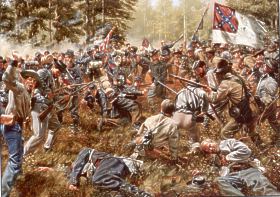Civil War Battles |
Colonial Wars |
American Wars |
Link To This Page — Contact Us —
The Battle of Peachtree Creek
July 20, 1864 in Fulton County, Georgia
Atlanta Campaign
Union Forces Commanded by:
Maj. Gen. George H. Thomas
Confederate Forces Commanded by: Gen. John B. Hood
**Missing and Captured Conclusion: Union Victory |
 |
BATTLE SUMMARY
North and west of Atlanta, nearly 100,000 men waited while Gen. William T. Sherman made a decision. Under Gen. Joseph E. Johnston, the Army of Tennessee had retired south of Peach Tree Creek, an east to west flowing stream, about 3 miles north of Atlanta. With only the Chattahoochee River and Johnston's Army of Tennessee between him and the city, he could move either south or east from Marietta to cross the mighty river that cuts through the center of Georgia from northeast to southwest. It was the last great physical barrier between Sherman and his prize.Each choice had tactical advantages but Sherman was a strategic thinker. By cutting the rail line to the east he would increase the amount of time it would take for re-enforcements to arrive from Richmond, lengthen Johnston's lines of communication and reduce the Confederate Army's access to grain and meat from Georgia's agricultural belt between Atlanta and Savannah. Yet unscathed, East Georgia offered Johnston much more food than Alabama, whose crops and cattle had been repeatedly scavenged.
Sherman's plan was simple. Maj. Gen. George H. George Thomas and his Army of the Cumberland would cross the Chattahoochee then hold the Confederate Army of Tennessee in place while McPherson and Schofield moved east to sever the rail connection to Savannah. Johnston, though had a surprise for the red-haired Ohioan. Rather than defend the Chattahoochee he would wait until Sherman crossed Peachtree Creek, then attack while the army was split in two.Unfortunately, Jefferson Davis replaced the cautious Johnston with Gen. John B. Hood on July 17, for while Johnston would only commit to reacting, Hood foolishly committed to acting upon the advances of the Union Army. Along quiet Peach Tree Creek north of Atlanta Hood's intentions became all too well-known to Thomas.
Advancing to the south had been easy for the Union army in May, as they out-flanked the Confederate army again and again. Ground became harder to come by in June and by July what had once been measured as miles a day could be measured in feet. After being repulsed by Confederates during a attempt to cross Peach Tree near Howell's Mill late in the day on July 19th, Union General Jefferson Davis crossed further east and gained high ground south of the rain-swollen river. From this advantage, Davis took the crossing at Howell's Mill. A third crossing was built just east of these.
Concentrating to a line about a mile wide The Army of the Cumberland crossed Peach Tree. Immediately east of Thomas was the flank of McPherson's Army of the Tennessee and Schofield's Army of the Ohio forming a secondary line some 8 miles in length. Originally set to attack at 1:00 P.M., the presence of these troops forced Hood to delay the initial assault until after 3:00 P.M. that afternoon while he strengthened his right flank.
The 5 hours of battle did not go well for the Confederates. Hood had lost the tactical advantage of having the Union Army split by the river; most of the Union Army had crossed by the time the battle started that afternoon. Now, instead of attacking an enemy split by a physical barrier, elements of the Confederate Army were advancing on 3 divisions of the Union Army entrenched on high ground.
Rather than attack as a single unit the Confederates rolled down the Union line. Only Maj. Gen. John Newton's division appeared to give way, but quick action by units on his left and right saved the day, catching the advancing Rebels in a withering enfilade. In the middle of the Union line a gap between "Fighting Joe" Hooker's XX Corps and Howard's VI Corps developed because of the inaccurate maps of the Union Commanders. Hood's troops completely missed the gap, failing to exploit this crucial error.
Continued attacks by the Confederates failed to produce results.
At sunset the Confederates called off the assault without any gains. Union commanders set about the task of burying the dead, and by their count more than 800 Confederate soldiers were put into the ground. With this many dead it tends to indicate that Hood underreported his losses by at least 2,000 men.
